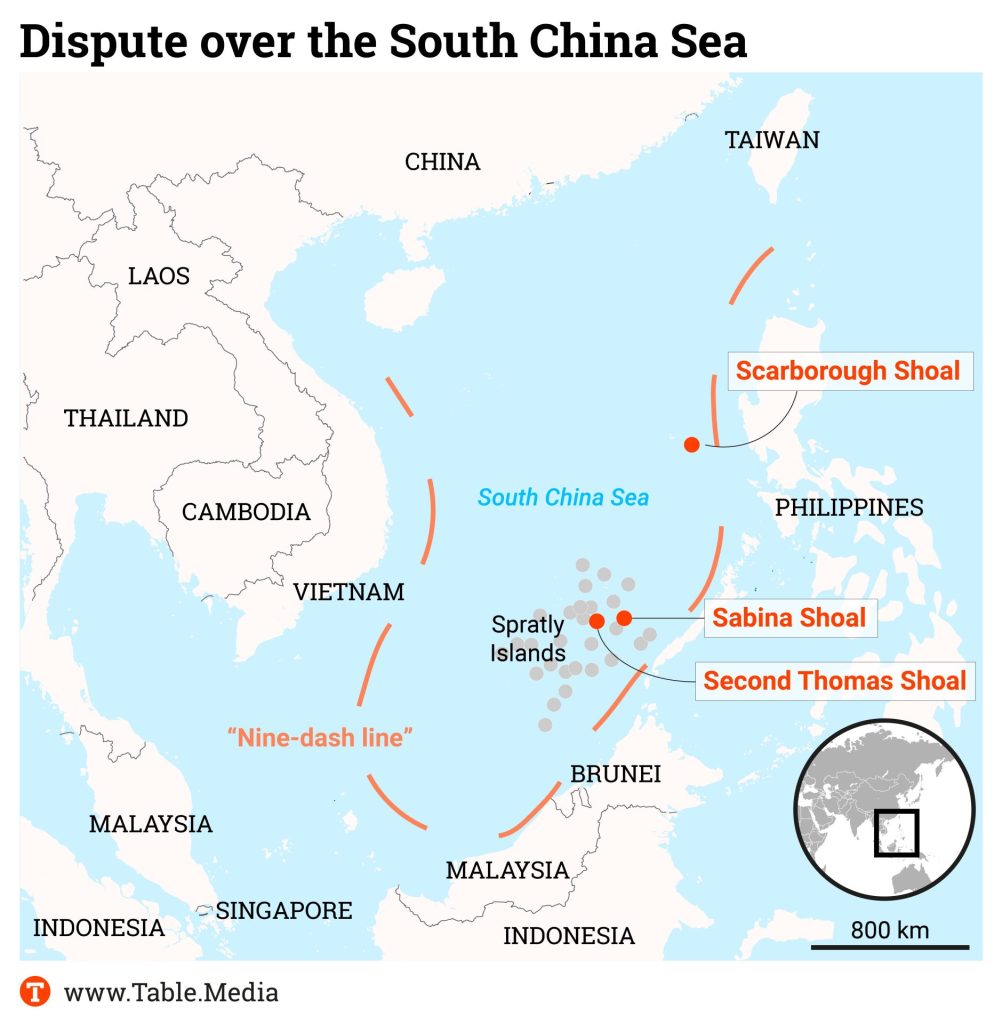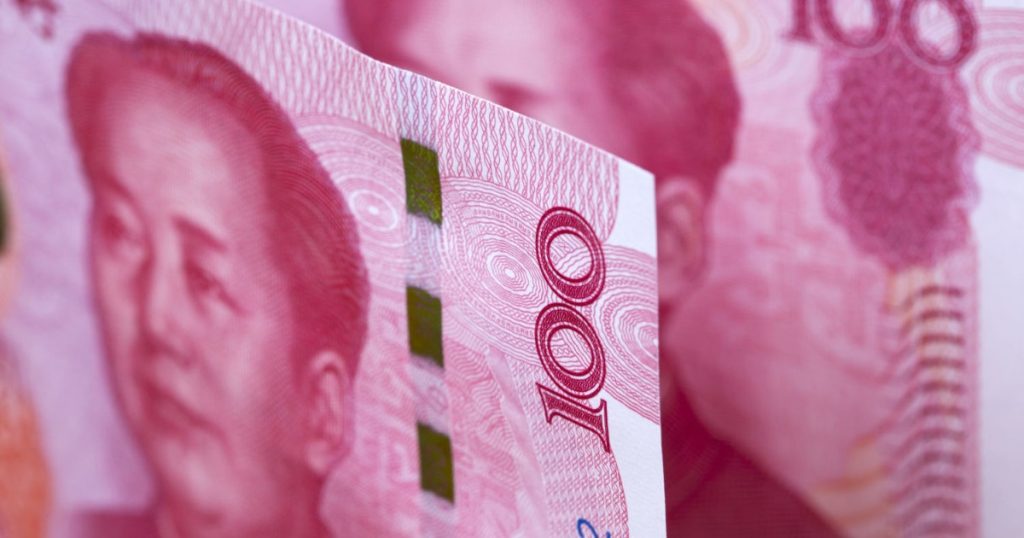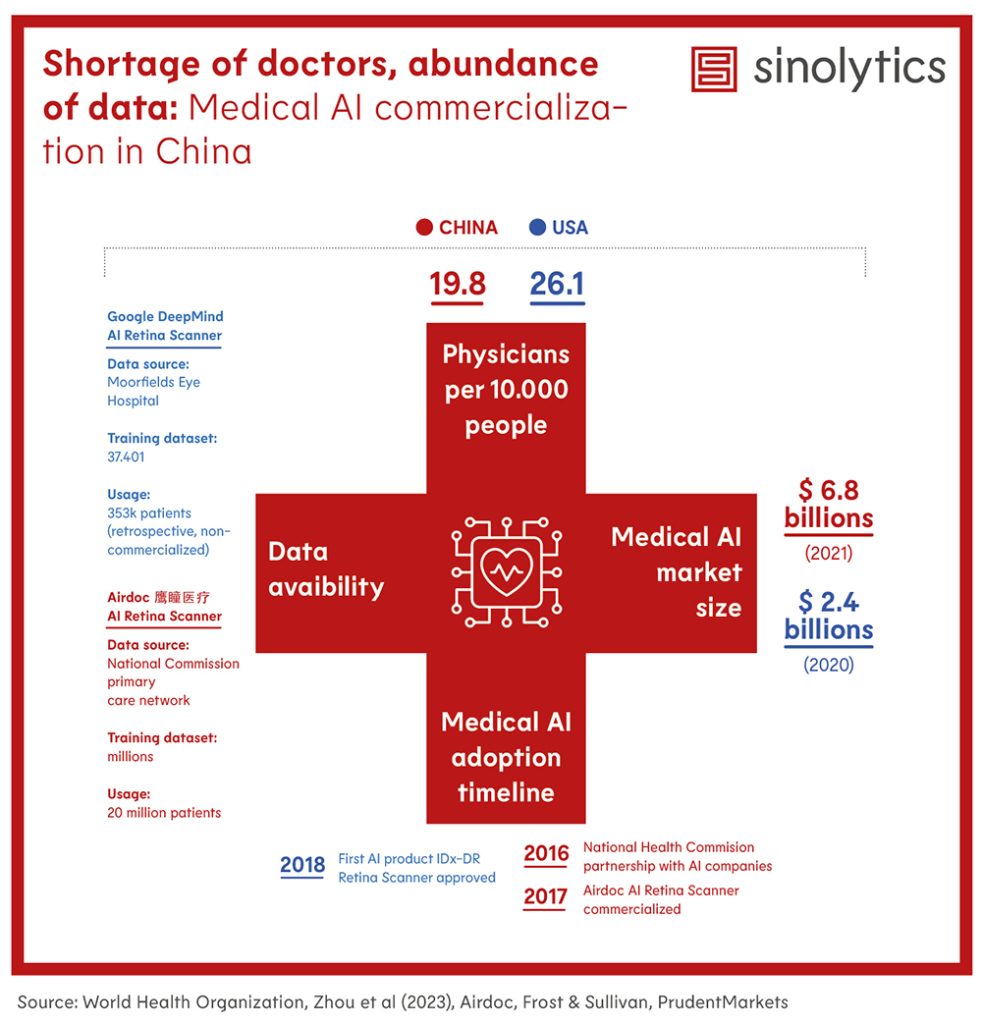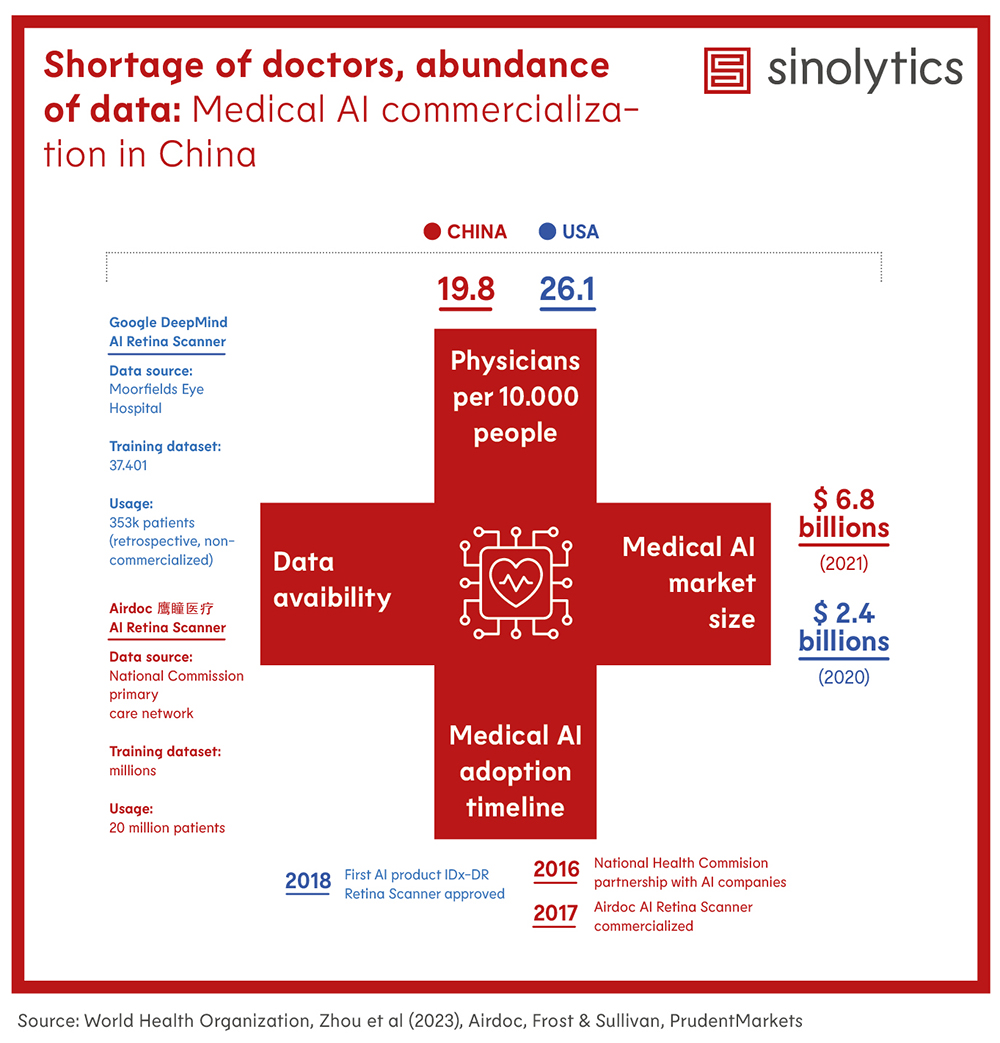The ongoing conflict between China and the Philippines in the South China Sea almost seems routine, with news of more or less dramatic clashes regularly appearing on the tickers. However, it would be a mistake to regard the current situation – with armed conflict threatening on three reefs – as ‘business as usual.’ Michael Radunski explains why and analyzes the confusing situation.
Should the situation escalate, the USA could also quickly be drawn into a military conflict. Washington not only has a defense pact with the Philippines, but also recently reopened an old base in the country. Just last week, the two countries carried out a full-scale military exercise.
In contrast, Beijing has some encouraging news for the economy: A bond that the People’s Republic will issue this Friday is expected to raise one trillion yuan (around 128 billion euros) over the year. Such a long-term special bond has only been issued four times in the country’s history.
The bond’s structure, announced in March, not only pleases analysts, who expect it to send a clearly positive signal for the economy – especially as more of these generously sized cash injections are planned for the coming years.


The conflict between the Philippines and China in the South China Sea is coming to a dramatic head. An armed conflict could break out on three reefs simultaneously.
China and the Philippines each invoke their supposedly legitimate rights. However, that is no longer the issue – at least since the Permanent Court of Arbitration ruling in The Hague. In July 2016, the court decided China’s claims along a nine-dash line were null and void. But Beijing refuses to accept the ruling. In fact, China’s leadership now seems willing to accept an armed conflict. But this could also quickly draw the USA into a military conflict.
The dispute over Scarborough Shoal currently has the greatest escalation potential. This week, the Philippines will send a civilian convoy to supply the local fishers with food and fuel. China apparently wants to preempt this. According to former US Air Force pilot Raymond Powell, Beijing has ordered a large fleet to the reef to intercept the Philippine convoy and deny it access. The People’s Republic sends at least four coast guard ships and 26 large naval militia vessels to the shallow sea. “It will be by far the biggest blockade I’ve ever seen in Scarborough,” Powell told Table.Briefings.
Powell, who heads Sealight – a project on transparency in maritime law at Stanford University – adds: “China seems determined to aggressively assert its claim to the shoal it took control of from the Philippines in 2012.”
However, for China, this is a routine coastguard operation. Officials claim that life-saving training is regularly carried out at the site to ensure the safety of Chinese fishing vessels in the region. Both sides insist on the legitimacy of their actions. And so it seems that a clash is inevitable in a few days – when the Philippine convoy arrives at Scarborough Shoal this week at the latest.
At Second Thomas Shoal, China is going on the offensive at a different level. Chinese officials recently stated that there is an unwritten agreement with the Philippines regarding access to the reef and the supply of the old stranded warship “Sierra Madre,” on which Filipino soldiers have been stationed for years. According to this agreement, the Philippines are allowed to supply the ship and the crew there, but are not allowed to carry out any construction work.
When President Ferdinand Marcos Jr.’s government denied the existence of such an agreement, China responded that the deal had been made with the previous president, Rodrigo Duterte. As proof, it published an audio recording in which the head of the Philippine Western Command, Vice Admiral Alberto Carlos, allegedly refers to such an agreement in a conversation with a Chinese diplomat-without, however, going into detail.

The problem: Vice Admiral Carlos is currently unavailable. The official line is that he is on “personal leave.” Former President Duterte, on the other hand, claims that he had only come to a “gentlemen’s agreement” with the Chinese side to maintain the “status quo.” So it’s one statement against another – and several questions remain unanswered:
Meanwhile, the situation at Second Thomas Shoal is coming to a head. The Sierra Madre is in a very poor state and is on the verge of breaking apart. This puts the Philippines under time pressure. And agreement or not, the Chinese brutally pushed back the Philippine supply mission in February with water cannons and ramming maneuvers.
The Philippines claim to have discovered that China is building an artificial island at Sabina Shoal. The accusation is not far-fetched, as Beijing has already done this in other places in the South China Sea. However, Beijing denies the allegations. “Recently, the Philippine side has repeatedly spread rumors, deliberately smeared China and attempted to mislead the international community, which is futile,” said a spokesperson for the Chinese Foreign Ministry.
The tension at Sabina Shoal stems from its location: The reef is strategically situated between the Philippine coast and Second Thomas Shoal. Ships pass through here to supply the Sierra Madre and the Philippine troops on Second Thomas Shoal. Now, the Philippines has sent its coast guard to investigate China’s activities on the reef.
The signs on all three reefs point to confrontation. China seems willing to accept an escalation. The Philippines, on the other hand, is increasingly finding itself on the defensive. Manila already took legal action via the International Court of Arbitration in 2016 – to no avail.
However, in the event of a violent conflict, it could quickly spiral out of control. The Philippines has signed a defense pact with the USA, and the US military has base rights in the Philippines. Recently, the USA even recommissioned an old base.
The military on the ground are already preparing for the worst: Just last Friday, the USA and the Philippines concluded their large-scale Balikatan military exercise involving more than 16,700 Filipino and US soldiers – including the Philippine Coast Guard for the first time. In response, China prompted the People’s Liberation Army’s Southern Theatre Command to conduct several anti-missile and anti-submarine drills in the area.

This Friday, China will start issuing a long-term special bond, which is expected to pump one trillion yuan (around 128 billion euros) into the economy this year. According to the Ministry of Finance in Beijing, the first step will be to offer securities worth 40 billion yuan with a term of 30 years.
The special bond announced at the National People’s Congress in March, whose launch date the markets had been eagerly awaiting, is a strong signal from the central government. This is the fourth time in the last 26 years that Beijing has resorted to such an instrument. In the past, it was always either to overcome a crisis or to make major changes.
Now the fourth round is coming. At the People’s Congress, Zheng Shanjie, head of the National Development and Reform Commission (NDRC), said that this was “a major policy to boost consumption and support long-term high-quality development.” The proceeds of the bond are to be used to promote “technology innovation, integrated urban-rural development, coordinated regional development, food and energy security, and high-quality population growth.”
Beijing is likely to see the new bond as a key component in implementing Xi Jinping’s economic course: Money is not to be distributed randomly, but rather to promote modernization and thus generate new growth.
It is also clear that the announced sum of one trillion yuan is by no means enough. The Party leadership announced at the People’s Congress that further long-term bonds will be issued in the coming years. If these were of a similar size, a huge sum would be raised for investment over the years.
Analysts already expect a significant growth effect this year. The bonds “increase the chance of achieving 5 percent growth,” Ding Shuang, chief economist for China and North Asia at Standard Chartered Bank, told Bloomberg. Xing Zhaopeng from the Australia & New Zealand Bank even assumes that the bond could increase gross domestic product growth by up to one percentage point.
Expert Xing believes the timing of the bond issue this Friday is also aimed at offsetting the effects of the new potential tariffs from the US. The bond could also dispel uncertainties in the run-up to the important Third Plenum of the Communist Party in July. This meeting is considered a key date at which the Communist Party traditionally determines the country’s medium-term economic course.
Jameson Zuo, Director at CSPI Credit Rating Co. in Hong Kong, emphasized: “The bond comes at a crucial time for China to reshape its debt structure.” Compared to global standards, “China still has significant room, potentially trillions of yuan worth of bond issuance over the next five to 10 years, to let the central government take up more leverage and boost investments,” Zuo told the Financial Times.
By issuing such special bonds, China also seems to have learned a lesson from the financial crisis of 2008 and 2009. Back then, Beijing launched an extensive economic stimulus program financed by issuing municipal bonds. These bonds were mainly issued by provincial and local governments – which often mismanaged or even squandered the money. Many municipalities continue to struggle with the high debt burden created back then.
Now the central government decides how it wants to spend the money. This gives it more control. However, this also means that local governments have less influence on the economic course.


Sinolytics is a research-based business consultancy entirely focused on China. It advises European companies on their strategic orientation and specific business activities in the People’s Republic.
As expected, the US government will impose special tariffs on a wide range of Chinese products. On Tuesday, the government announced in Washington that tariffs on electric cars will be raised from 25 to 100 percent. Lithium-ion batteries for electric vehicles and other battery parts will be subject to 25 percent tariffs instead of the previous 7.5 percent. Washington is doubling the tariff rate on solar cells and semiconductors to 50 percent. Tariffs will also be imposed on certain critical materials, port cranes and medical products such as cannulas and protective masks.
With this move, the US further fuelled the trade conflict between the two superpowers. China is flooding the global markets with artificially cheap exports at the expense of domestic manufacturers – this is how the White House justifies the measures. The United States has been lamenting an enormous trade deficit with China for decades. However, Chinese electric car manufacturers, in particular, largely avoid the US market anyway, precisely because of geopolitical tensions. Other companies, such as the solar manufacturer Longi Green Energy, have invested in the USA: Working with the US company Invenergy, Longi founded a joint venture called Illuminate USA, which has been manufacturing solar modules in Ohio since February, although the Chinese co-owner keeps this information somewhat hidden on its website.
In advance, Beijing reacted to the special tariffs with harsh criticism and announced it would “take all necessary measures” to defend its own interests. A new tariff race is looming, which could also affect the EU. “The EU will now follow suit, because the French have already got the argument ‘now the avalanche is rolling towards Europe’ in the drawer with (French President, ed.) Macron,” car expert Ferdinand Dudenhoeffer expects. In an interview with Bloomberg on Tuesday, Macron described punitive tariffs on Chinese EVs as a “no-brainer.” He said it was not about geopolitics: “What we want is just reciprocity.” The EU currently imposes tariffs of ten percent on electric cars, while China imposes between 15 and 24 percent.
Conversely, German Chancellor Olaf Scholz and Swedish Prime Minister Ulf Kristersson jointly expressed their opposition to EU punitive tariffs against Chinese EVs in Stockholm on Tuesday. Scholz pointed out that “currently at least 50 percent of imports of electric vehicles from China are from Western brands that produce there themselves and import them to Europe.” This is what distinguishes Europe from America. Kristersson also expressed his disapproval: “We don’t want to dismantle global trade, that’s a stupid idea.”
Bernd Lange, Chair of the European Parliament’s Committee on International Trade, fears that the EU economy will suffer. “We could pay a large part of the price, as it is possible that Chinese e-vehicles, for example, will find their way into the EU more easily.” This move would add an “inglorious chapter to the America First saga.” He added: “The US is taking its decoupling strategy from China to the next level and is thus strengthening its confrontational approach.” These extra tariffs should primarily satisfy a small section of voters who could be decisive in November’s presidential elections. ck/rtr
Russian President Vladimir Putin will visit China on Thursday and Friday at the invitation of the Chinese President. Hua Chunying, China’s deputy foreign minister, announced the exact dates of the planned state visit – the first foreign trip in Putin’s fifth term of office – on Tuesday. The Kremlin also provided a few details, explaining in a statement that Putin would visit Beijing and Harbin. Negotiations with Xi and the signing of a number of documents are planned.
Putin and Xi will also attend a gala evening to mark the 75th anniversary of the establishment of diplomatic relations and the opening of the Years of Culture between Russia and China. During his visit, Putin will also meet with Chinese Prime Minister Li Qiang. In Harbin, a city with historical ties to Russia, Putin will attend the opening of the eighth Russian-Chinese Expo and the fourth Forum for Interregional Cooperation, as well as meet with students and lecturers from Harbin Polytechnic University, according to the Kremlin.
With this program, China and Russia are demonstrating ‘business as usual.’ However, there is growing resentment in the West about the close trade relations between the two countries. In particular, accusations are being leveled that Chinese companies are supporting the Russian war in Ukraine with dual-use goods. “The Russians want China to do more to support it,” Alexander Gabuev, Director of the Carnegie Russia Eurasia Center, told AFP. However, the government in Beijing is hesitating as it does not want to jeopardize its relations with the West, he added. cyb
The Chinese company Hesai Technology has filed a lawsuit against the US Department of Defense. Hesai wants the Pentagon to remove the company from its blacklist of Chinese firms suspected of collaborating with the military. According to Reuters, Hesai, a developer of LIDAR sensor technologies for self-driving cars, was placed on the list in January along with a dozen other companies since the government of former President Donald Trump.
This list also includes large corporations such as Huawei and Semiconductor Manufacturing International (SMIC). Although being blacklisted does not directly prohibit doing business with these companies, it is seen as a warning to US companies and institutions against doing business with them. According to Hesai’s complaint, inclusion in the so-called 1260H list has resulted in “serious reputational injury, a significant drop in stock price, and lost business opportunities.” The company has been listed on the NASDAQ in New York since the beginning of 2023. According to the lawsuit, it is majority-owned by shareholders located outside of China.
Hesai also rejected accusations of cooperating with China’s military: “No Chinese governmental or military entity has sought to exert influence or control over the Hesai Group’s management, strategy, or research-and development operation.” The company says it only develops and produces for commercial and civilian purposes. Moreover, the Pentagon did not warn Hesai before listing it and thus did not give it an opportunity to defend itself. The Ministry of Defense told Reuters it does not comment on legal disputes.
Since the US introduced the blacklists during the administration of former President Donald Trump, Chinese companies have repeatedly tried to take legal action against them, Bloomberg reported. In 2021, the current administration of President Joe Biden agreed to remove the electronics company Xiaomi from the list after a US court sided with the company. Other companies sought out-of-court settlements. IDG Capital, a venture firm with offices in Beijing and Hong Kong, said in February that it was working to clear up the “confusion” about why it was on the list. The lawsuit said Hesai had also tried to do so, but received “no substantive response” from the government. ck/rtr
On Monday, the EU Commission published recommendations and guidance on the Renewable Energy Directive (RED). They focus on accelerated planning, the designation of acceleration areas for renewable energy and the auction design. In addition, a platform has been renewed on which the member states publish information on their tenders.
The recommendations also detail the less favorable treatment of Chinese technology providers in tenders for renewables. According to the Guidelines on State Aid for Climate, Environmental Protection and Energy and the Temporary Crisis Technical Assistance Framework (TCTF), member states can set requirements for 30 percent of the tender criteria other than price. This includes, for instance, cyber security criteria for components, which are also required by the Net-Zero Industry Act (NZIA).
The current recommendations affect the wind industry in particular: “One criterion could be the security-by-design of digital networks in wind turbines.” In the staff working document, the Commission also urges EU member states to make uniformly high efforts. It encourages member states to adopt robust cybersecurity rules to ensure that the EU’s weakest links are not exploited.
According to the recommendations, foreign turbine manufacturers must conduct risk assessments and document how they handle data and where it is stored. “Chinese companies could certainly set this up after a transition phase, but they do not currently accept this requirement,” says the wind industry. “This could therefore lead to exclusions in the future.” ber
Christian Inan has been the new IT / Digitalization Production & Logistics Specialist at Audi FAW NEV since April. He has been working for the electric car joint venture in China in Changchun since October 2023.
Lei Haichao is the new Party Secretary of the National Health Commission (NHC). The long-serving health official was previously Deputy Party Chief of the country’s highest health authority. Lei replaces 65-year-old Ma Xiaowei, whose whereabouts the NHC did not initially disclose.
Is something changing in your organization? Let us know at heads@table.media!

Photographed by the billions – and never fails to amaze: flooded rice terraces against the light. In many regions, rice cultivation is still hard manual work, partly because larger equipment cannot be used on the narrow, winding terraced fields. And so the areas under cultivation, such as here in the village of Shiyuan in the southern province of Guizhou, remain one of the few things that have not yet radically changed in China’s economy.
The ongoing conflict between China and the Philippines in the South China Sea almost seems routine, with news of more or less dramatic clashes regularly appearing on the tickers. However, it would be a mistake to regard the current situation – with armed conflict threatening on three reefs – as ‘business as usual.’ Michael Radunski explains why and analyzes the confusing situation.
Should the situation escalate, the USA could also quickly be drawn into a military conflict. Washington not only has a defense pact with the Philippines, but also recently reopened an old base in the country. Just last week, the two countries carried out a full-scale military exercise.
In contrast, Beijing has some encouraging news for the economy: A bond that the People’s Republic will issue this Friday is expected to raise one trillion yuan (around 128 billion euros) over the year. Such a long-term special bond has only been issued four times in the country’s history.
The bond’s structure, announced in March, not only pleases analysts, who expect it to send a clearly positive signal for the economy – especially as more of these generously sized cash injections are planned for the coming years.


The conflict between the Philippines and China in the South China Sea is coming to a dramatic head. An armed conflict could break out on three reefs simultaneously.
China and the Philippines each invoke their supposedly legitimate rights. However, that is no longer the issue – at least since the Permanent Court of Arbitration ruling in The Hague. In July 2016, the court decided China’s claims along a nine-dash line were null and void. But Beijing refuses to accept the ruling. In fact, China’s leadership now seems willing to accept an armed conflict. But this could also quickly draw the USA into a military conflict.
The dispute over Scarborough Shoal currently has the greatest escalation potential. This week, the Philippines will send a civilian convoy to supply the local fishers with food and fuel. China apparently wants to preempt this. According to former US Air Force pilot Raymond Powell, Beijing has ordered a large fleet to the reef to intercept the Philippine convoy and deny it access. The People’s Republic sends at least four coast guard ships and 26 large naval militia vessels to the shallow sea. “It will be by far the biggest blockade I’ve ever seen in Scarborough,” Powell told Table.Briefings.
Powell, who heads Sealight – a project on transparency in maritime law at Stanford University – adds: “China seems determined to aggressively assert its claim to the shoal it took control of from the Philippines in 2012.”
However, for China, this is a routine coastguard operation. Officials claim that life-saving training is regularly carried out at the site to ensure the safety of Chinese fishing vessels in the region. Both sides insist on the legitimacy of their actions. And so it seems that a clash is inevitable in a few days – when the Philippine convoy arrives at Scarborough Shoal this week at the latest.
At Second Thomas Shoal, China is going on the offensive at a different level. Chinese officials recently stated that there is an unwritten agreement with the Philippines regarding access to the reef and the supply of the old stranded warship “Sierra Madre,” on which Filipino soldiers have been stationed for years. According to this agreement, the Philippines are allowed to supply the ship and the crew there, but are not allowed to carry out any construction work.
When President Ferdinand Marcos Jr.’s government denied the existence of such an agreement, China responded that the deal had been made with the previous president, Rodrigo Duterte. As proof, it published an audio recording in which the head of the Philippine Western Command, Vice Admiral Alberto Carlos, allegedly refers to such an agreement in a conversation with a Chinese diplomat-without, however, going into detail.

The problem: Vice Admiral Carlos is currently unavailable. The official line is that he is on “personal leave.” Former President Duterte, on the other hand, claims that he had only come to a “gentlemen’s agreement” with the Chinese side to maintain the “status quo.” So it’s one statement against another – and several questions remain unanswered:
Meanwhile, the situation at Second Thomas Shoal is coming to a head. The Sierra Madre is in a very poor state and is on the verge of breaking apart. This puts the Philippines under time pressure. And agreement or not, the Chinese brutally pushed back the Philippine supply mission in February with water cannons and ramming maneuvers.
The Philippines claim to have discovered that China is building an artificial island at Sabina Shoal. The accusation is not far-fetched, as Beijing has already done this in other places in the South China Sea. However, Beijing denies the allegations. “Recently, the Philippine side has repeatedly spread rumors, deliberately smeared China and attempted to mislead the international community, which is futile,” said a spokesperson for the Chinese Foreign Ministry.
The tension at Sabina Shoal stems from its location: The reef is strategically situated between the Philippine coast and Second Thomas Shoal. Ships pass through here to supply the Sierra Madre and the Philippine troops on Second Thomas Shoal. Now, the Philippines has sent its coast guard to investigate China’s activities on the reef.
The signs on all three reefs point to confrontation. China seems willing to accept an escalation. The Philippines, on the other hand, is increasingly finding itself on the defensive. Manila already took legal action via the International Court of Arbitration in 2016 – to no avail.
However, in the event of a violent conflict, it could quickly spiral out of control. The Philippines has signed a defense pact with the USA, and the US military has base rights in the Philippines. Recently, the USA even recommissioned an old base.
The military on the ground are already preparing for the worst: Just last Friday, the USA and the Philippines concluded their large-scale Balikatan military exercise involving more than 16,700 Filipino and US soldiers – including the Philippine Coast Guard for the first time. In response, China prompted the People’s Liberation Army’s Southern Theatre Command to conduct several anti-missile and anti-submarine drills in the area.

This Friday, China will start issuing a long-term special bond, which is expected to pump one trillion yuan (around 128 billion euros) into the economy this year. According to the Ministry of Finance in Beijing, the first step will be to offer securities worth 40 billion yuan with a term of 30 years.
The special bond announced at the National People’s Congress in March, whose launch date the markets had been eagerly awaiting, is a strong signal from the central government. This is the fourth time in the last 26 years that Beijing has resorted to such an instrument. In the past, it was always either to overcome a crisis or to make major changes.
Now the fourth round is coming. At the People’s Congress, Zheng Shanjie, head of the National Development and Reform Commission (NDRC), said that this was “a major policy to boost consumption and support long-term high-quality development.” The proceeds of the bond are to be used to promote “technology innovation, integrated urban-rural development, coordinated regional development, food and energy security, and high-quality population growth.”
Beijing is likely to see the new bond as a key component in implementing Xi Jinping’s economic course: Money is not to be distributed randomly, but rather to promote modernization and thus generate new growth.
It is also clear that the announced sum of one trillion yuan is by no means enough. The Party leadership announced at the People’s Congress that further long-term bonds will be issued in the coming years. If these were of a similar size, a huge sum would be raised for investment over the years.
Analysts already expect a significant growth effect this year. The bonds “increase the chance of achieving 5 percent growth,” Ding Shuang, chief economist for China and North Asia at Standard Chartered Bank, told Bloomberg. Xing Zhaopeng from the Australia & New Zealand Bank even assumes that the bond could increase gross domestic product growth by up to one percentage point.
Expert Xing believes the timing of the bond issue this Friday is also aimed at offsetting the effects of the new potential tariffs from the US. The bond could also dispel uncertainties in the run-up to the important Third Plenum of the Communist Party in July. This meeting is considered a key date at which the Communist Party traditionally determines the country’s medium-term economic course.
Jameson Zuo, Director at CSPI Credit Rating Co. in Hong Kong, emphasized: “The bond comes at a crucial time for China to reshape its debt structure.” Compared to global standards, “China still has significant room, potentially trillions of yuan worth of bond issuance over the next five to 10 years, to let the central government take up more leverage and boost investments,” Zuo told the Financial Times.
By issuing such special bonds, China also seems to have learned a lesson from the financial crisis of 2008 and 2009. Back then, Beijing launched an extensive economic stimulus program financed by issuing municipal bonds. These bonds were mainly issued by provincial and local governments – which often mismanaged or even squandered the money. Many municipalities continue to struggle with the high debt burden created back then.
Now the central government decides how it wants to spend the money. This gives it more control. However, this also means that local governments have less influence on the economic course.


Sinolytics is a research-based business consultancy entirely focused on China. It advises European companies on their strategic orientation and specific business activities in the People’s Republic.
As expected, the US government will impose special tariffs on a wide range of Chinese products. On Tuesday, the government announced in Washington that tariffs on electric cars will be raised from 25 to 100 percent. Lithium-ion batteries for electric vehicles and other battery parts will be subject to 25 percent tariffs instead of the previous 7.5 percent. Washington is doubling the tariff rate on solar cells and semiconductors to 50 percent. Tariffs will also be imposed on certain critical materials, port cranes and medical products such as cannulas and protective masks.
With this move, the US further fuelled the trade conflict between the two superpowers. China is flooding the global markets with artificially cheap exports at the expense of domestic manufacturers – this is how the White House justifies the measures. The United States has been lamenting an enormous trade deficit with China for decades. However, Chinese electric car manufacturers, in particular, largely avoid the US market anyway, precisely because of geopolitical tensions. Other companies, such as the solar manufacturer Longi Green Energy, have invested in the USA: Working with the US company Invenergy, Longi founded a joint venture called Illuminate USA, which has been manufacturing solar modules in Ohio since February, although the Chinese co-owner keeps this information somewhat hidden on its website.
In advance, Beijing reacted to the special tariffs with harsh criticism and announced it would “take all necessary measures” to defend its own interests. A new tariff race is looming, which could also affect the EU. “The EU will now follow suit, because the French have already got the argument ‘now the avalanche is rolling towards Europe’ in the drawer with (French President, ed.) Macron,” car expert Ferdinand Dudenhoeffer expects. In an interview with Bloomberg on Tuesday, Macron described punitive tariffs on Chinese EVs as a “no-brainer.” He said it was not about geopolitics: “What we want is just reciprocity.” The EU currently imposes tariffs of ten percent on electric cars, while China imposes between 15 and 24 percent.
Conversely, German Chancellor Olaf Scholz and Swedish Prime Minister Ulf Kristersson jointly expressed their opposition to EU punitive tariffs against Chinese EVs in Stockholm on Tuesday. Scholz pointed out that “currently at least 50 percent of imports of electric vehicles from China are from Western brands that produce there themselves and import them to Europe.” This is what distinguishes Europe from America. Kristersson also expressed his disapproval: “We don’t want to dismantle global trade, that’s a stupid idea.”
Bernd Lange, Chair of the European Parliament’s Committee on International Trade, fears that the EU economy will suffer. “We could pay a large part of the price, as it is possible that Chinese e-vehicles, for example, will find their way into the EU more easily.” This move would add an “inglorious chapter to the America First saga.” He added: “The US is taking its decoupling strategy from China to the next level and is thus strengthening its confrontational approach.” These extra tariffs should primarily satisfy a small section of voters who could be decisive in November’s presidential elections. ck/rtr
Russian President Vladimir Putin will visit China on Thursday and Friday at the invitation of the Chinese President. Hua Chunying, China’s deputy foreign minister, announced the exact dates of the planned state visit – the first foreign trip in Putin’s fifth term of office – on Tuesday. The Kremlin also provided a few details, explaining in a statement that Putin would visit Beijing and Harbin. Negotiations with Xi and the signing of a number of documents are planned.
Putin and Xi will also attend a gala evening to mark the 75th anniversary of the establishment of diplomatic relations and the opening of the Years of Culture between Russia and China. During his visit, Putin will also meet with Chinese Prime Minister Li Qiang. In Harbin, a city with historical ties to Russia, Putin will attend the opening of the eighth Russian-Chinese Expo and the fourth Forum for Interregional Cooperation, as well as meet with students and lecturers from Harbin Polytechnic University, according to the Kremlin.
With this program, China and Russia are demonstrating ‘business as usual.’ However, there is growing resentment in the West about the close trade relations between the two countries. In particular, accusations are being leveled that Chinese companies are supporting the Russian war in Ukraine with dual-use goods. “The Russians want China to do more to support it,” Alexander Gabuev, Director of the Carnegie Russia Eurasia Center, told AFP. However, the government in Beijing is hesitating as it does not want to jeopardize its relations with the West, he added. cyb
The Chinese company Hesai Technology has filed a lawsuit against the US Department of Defense. Hesai wants the Pentagon to remove the company from its blacklist of Chinese firms suspected of collaborating with the military. According to Reuters, Hesai, a developer of LIDAR sensor technologies for self-driving cars, was placed on the list in January along with a dozen other companies since the government of former President Donald Trump.
This list also includes large corporations such as Huawei and Semiconductor Manufacturing International (SMIC). Although being blacklisted does not directly prohibit doing business with these companies, it is seen as a warning to US companies and institutions against doing business with them. According to Hesai’s complaint, inclusion in the so-called 1260H list has resulted in “serious reputational injury, a significant drop in stock price, and lost business opportunities.” The company has been listed on the NASDAQ in New York since the beginning of 2023. According to the lawsuit, it is majority-owned by shareholders located outside of China.
Hesai also rejected accusations of cooperating with China’s military: “No Chinese governmental or military entity has sought to exert influence or control over the Hesai Group’s management, strategy, or research-and development operation.” The company says it only develops and produces for commercial and civilian purposes. Moreover, the Pentagon did not warn Hesai before listing it and thus did not give it an opportunity to defend itself. The Ministry of Defense told Reuters it does not comment on legal disputes.
Since the US introduced the blacklists during the administration of former President Donald Trump, Chinese companies have repeatedly tried to take legal action against them, Bloomberg reported. In 2021, the current administration of President Joe Biden agreed to remove the electronics company Xiaomi from the list after a US court sided with the company. Other companies sought out-of-court settlements. IDG Capital, a venture firm with offices in Beijing and Hong Kong, said in February that it was working to clear up the “confusion” about why it was on the list. The lawsuit said Hesai had also tried to do so, but received “no substantive response” from the government. ck/rtr
On Monday, the EU Commission published recommendations and guidance on the Renewable Energy Directive (RED). They focus on accelerated planning, the designation of acceleration areas for renewable energy and the auction design. In addition, a platform has been renewed on which the member states publish information on their tenders.
The recommendations also detail the less favorable treatment of Chinese technology providers in tenders for renewables. According to the Guidelines on State Aid for Climate, Environmental Protection and Energy and the Temporary Crisis Technical Assistance Framework (TCTF), member states can set requirements for 30 percent of the tender criteria other than price. This includes, for instance, cyber security criteria for components, which are also required by the Net-Zero Industry Act (NZIA).
The current recommendations affect the wind industry in particular: “One criterion could be the security-by-design of digital networks in wind turbines.” In the staff working document, the Commission also urges EU member states to make uniformly high efforts. It encourages member states to adopt robust cybersecurity rules to ensure that the EU’s weakest links are not exploited.
According to the recommendations, foreign turbine manufacturers must conduct risk assessments and document how they handle data and where it is stored. “Chinese companies could certainly set this up after a transition phase, but they do not currently accept this requirement,” says the wind industry. “This could therefore lead to exclusions in the future.” ber
Christian Inan has been the new IT / Digitalization Production & Logistics Specialist at Audi FAW NEV since April. He has been working for the electric car joint venture in China in Changchun since October 2023.
Lei Haichao is the new Party Secretary of the National Health Commission (NHC). The long-serving health official was previously Deputy Party Chief of the country’s highest health authority. Lei replaces 65-year-old Ma Xiaowei, whose whereabouts the NHC did not initially disclose.
Is something changing in your organization? Let us know at heads@table.media!

Photographed by the billions – and never fails to amaze: flooded rice terraces against the light. In many regions, rice cultivation is still hard manual work, partly because larger equipment cannot be used on the narrow, winding terraced fields. And so the areas under cultivation, such as here in the village of Shiyuan in the southern province of Guizhou, remain one of the few things that have not yet radically changed in China’s economy.
